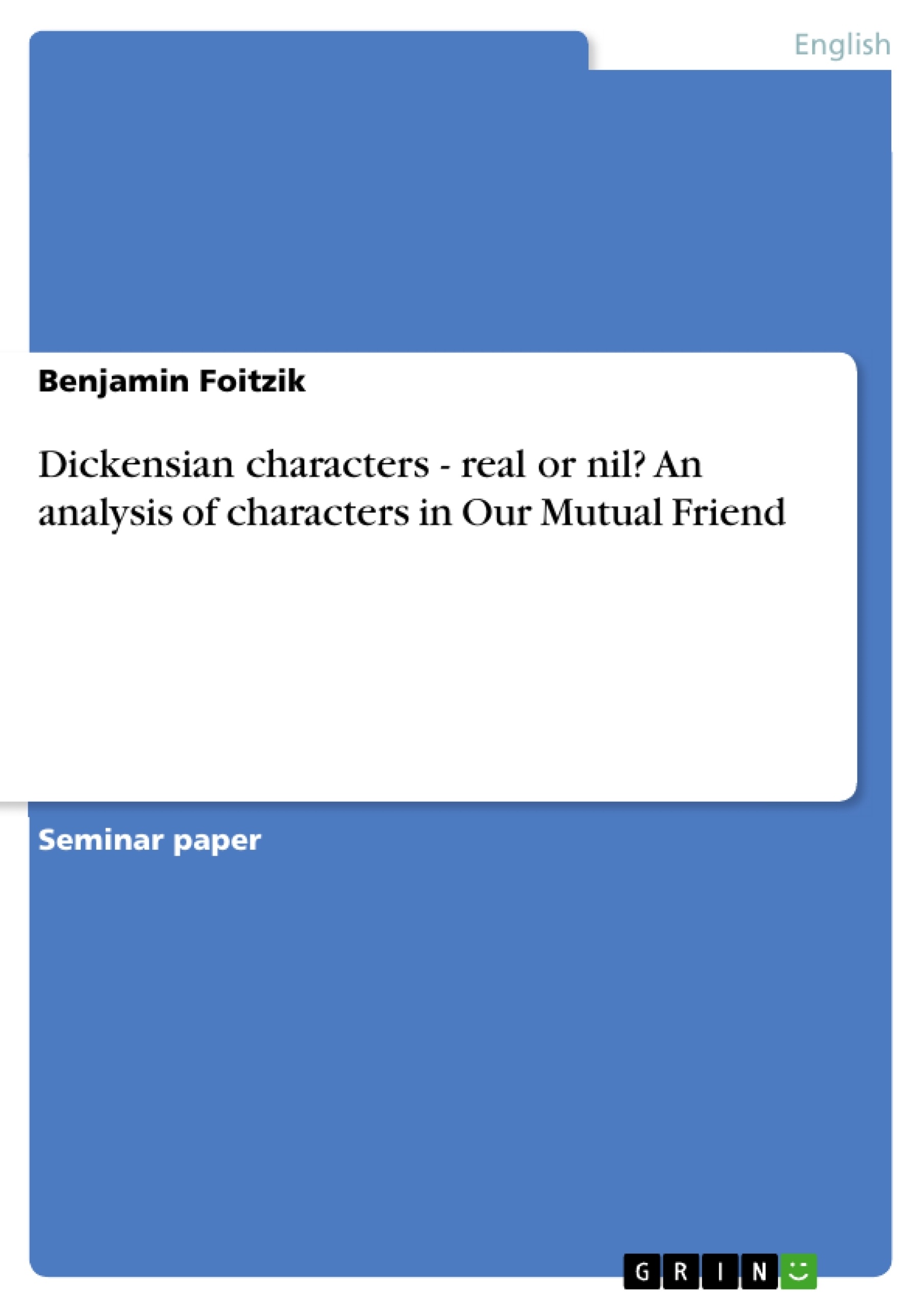To begin with the end, the overall statement of this paper is that the characters in Charles Dickens′s Our Mutual Friend are for the most part inconsistent. In order to clarify this assertion to the reader, I will at first provide an overview of how Dickens′s characters were received by various critics. This will be the foundation for my claim that his characters are not realistic since they are only described from the outside and, thus, character-development is only achieved by means of the plot. This lack of introspection derives from the fact that Dickens′s focus as a writer was surely on social issues and not on character-development. That Dickens was a great novelist will not be questioned, seeing that, despite this lack of interiority and the ensuing incoherence of the characters to the critic, his characters work during the experience of the first reading. This I will show by examining the character of Eugene Wrayburn in Our Mutual Friend, whose final catharsis is approved of by the reader at first, but has to be highly doubted at second sight, as his actions and thoughts do not justify his reformation to a person of integrity. A thorough study of Wrayburn′s character will reveal that he is a sadist who exults in humiliating other people and wielding power over them, which will raise the question whether he has to be considered as a villainous rather than heroic character.
I will then investigate the character of Bradley Headstone, who appears to be the villain of the subplot revolving around Lizzie Hexam. This analysis will lead to the discovery that Headstone is not so much of a villain but has to be seen as a victim of society and its machinery. Headstone′s story has to be seen as tragic since he succumbs to his violent passions and lets them drive him to despair and the edge of reason in the end. In addition, I will juxtapose Wrayburn′s character to that of his opponent Headstone and thus illustrates the fact that, while we do not get an insight into Wrayburn′s emotions and therefore cannot understand his deeds, Headstone′s actions and motivations are rendered plausible for the reader by the way Dickens describes his character, from the outside as well as from the inside. [...]
Inhaltsverzeichnis (Table of Contents)
- Introduction
- General aspects on Dickensian characters
- Eugene Wrayburn - Catharsis or conundrum?
- The Wrayburn-dilemma
- Fascination Wrayburn – The man without designs
- Wrayburn's 'reparation' - A farce
- Bradley Headstone - Villain or victim?
- The social inferiority-complex
- The tragedy of a \"curious monomaniac”
- The clash of the classes and a cry for help
- Sadism meets the inferiority-complex
- Bradley Headstone - Guilty of emotion
- Conclusion
Zielsetzung und Themenschwerpunkte (Objectives and Key Themes)
This paper argues that the characters in Charles Dickens's Our Mutual Friend are generally inconsistent. The main objective of the paper is to examine the characters of Eugene Wrayburn and Bradley Headstone in order to explore this claim and further analyze Dickens's portrayal of characters in his work. The analysis will consider the reception of Dickens's characters by critics and explore the question of whether these characters are truly realistic or merely superficial constructs.
- The inconsistency of Dickensian characters
- The portrayal of characters from the outside
- The focus on social issues over character development
- The concept of realism in literary characters
- The clash between the classes and its impact on individual characters
Zusammenfassung der Kapitel (Chapter Summaries)
- Introduction: This chapter introduces the paper's main argument – the inconsistency of characters in Our Mutual Friend. It sets the stage for the analysis by outlining the paper's approach and its focus on the characters of Eugene Wrayburn and Bradley Headstone. It briefly discusses the reception of Dickens's characters by critics and suggests that their lack of introspection might be a result of Dickens's focus on social issues.
- General aspects on Dickensian characters: This chapter delves into the debate surrounding the nature of Dickensian characters. It presents a range of critical perspectives on Dickens's characterization, highlighting both praise and criticism. The chapter then explores the concept of realism in literary characters and attempts to define what constitutes a "realistic" character. It highlights the subjectivity inherent in judging realism and suggests that comprehensibility of a character's actions and thoughts contributes to their believability.
- Eugene Wrayburn - Catharsis or conundrum?: This chapter focuses on the character of Eugene Wrayburn, examining his alleged reformation and questioning its authenticity. It suggests that Wrayburn might be a sadist who enjoys power over others and raises the question of whether he is truly a heroic character. The analysis explores the complexities of his character and challenges the reader to consider his actions and motivations in a nuanced light.
- Bradley Headstone - Villain or victim?: This chapter shifts its focus to Bradley Headstone, exploring his role as the villain in the subplot revolving around Lizzie Hexam. It argues that Headstone is not simply a villain but rather a victim of society and its inequalities. The chapter analyzes Headstone's story as a tragic one, driven by his violent passions and ultimately leading to his despair. It highlights the clash between Wrayburn and Headstone as a representation of the disparity in their social positions and the resulting disparity in their portrayal by Dickens.
Schlüsselwörter (Keywords)
This paper explores the themes of character development, social commentary, realism, and the portrayal of class disparities in Charles Dickens's Our Mutual Friend. It examines the complex characters of Eugene Wrayburn and Bradley Headstone, highlighting the interplay between their individual flaws and their societal contexts. Key terms include character inconsistency, social inferiority, interiority, and the subjective nature of realism in literature.
- Quote paper
- Benjamin Foitzik (Author), 2002, Dickensian characters - real or nil? An analysis of characters in Our Mutual Friend, Munich, GRIN Verlag, https://www.hausarbeiten.de/document/12125


